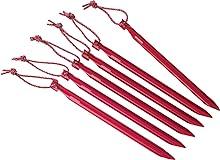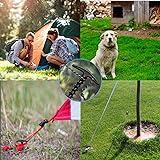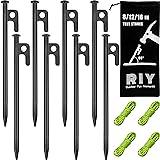Hello campers. Today we are going to discuss the importance of picking the right tent stakes. We will also give our suggestions based on our own experiences. Back when we lived in Kansas, we didn’t think much about which tent stakes we used for camping because they all worked. But all that changed when we moved to New Mexico! Here, the ground and the weather are very different. It’s often windy here, and the ground can be hard, sandy, and/or rocky. After a couple frustrating experiences we learned how important it is to choose the right tent stakes to keep our tent safe and secure.
Before we jump in we want to recommend that you pack several types of tent stakes. They are affordable, light, and easy to pack so there is really no reason to only bring one set. This way, whatever type of ground or wind conditions you encounter you will be prepared. We also recommend bringing extra cordage in case there are natural anchors you can take advantage of. We have a short guide on picking the right ropes and cords if you are interested.
tldr;
In a rush, no worries. For most camping situations, we recommend bringing either groundhog or screw-type stakes for soft or grassy soils, as they provide excellent grip and stability. For challenging environments like rocky or frozen terrain, heavy-duty steel stakes (similar to large nails) are your best bet. These two types of stakes will cover a wide range of conditions, ensuring your tent stays secure no matter where you set up camp.
For Soft Soil and Grass
This is the kind of soil we were most used to and honestly, pretty much any tent stakes will work as long as it’s not windy. We find that the aluminum “Y” shaped tent stakes work great. If you want to be sure your tent wont fly away in high winds stakes that twist into the ground, like spiral or screw-type stakes. They dig deep and hold tight, making sure your tent stays put, even on soft ground.

MSR Groundhog Tent Stake Kit

T Shape Spiral Ground Stakes
For Sandy or Loose Soil
If you’re setting up your tent on sandy or loose soil the ground won’t hold regular stakes well. You should look for stakes that are sometimes called “sand stakes” or “snow stakes.” These stakes are usually shorter but broader and flatter, which helps them spread out the force and stay put in the sand. Their shape makes it harder for them to sink or pull out, keeping your tent stable even on loose ground.

COBARYEN Tent Stakes Sand Stakes for Beach Tent 6 Pack Spiral Anchor Stakes 9.4 Inch Heavy Duty Screw Canopy Stakes for Camping, Hiking and More (6, Green)
For Hard Rocky Soil
Camping on hard, rocky soil means you need really strong tent stakes. The best ones are usually made of steel and look a bit like big nails. These are strong enough to get into the rocky ground without bending or breaking. You’ll need a hammer or mallet to drive them in properly, but once they’re in, they do a great job of keeping your tent secure.

8 Pack Tent Stakes Heavy Duty Metal Tent Pegs for Camping Steel Tent Stakes 8 inch Unbreakable and Inflexible
For Snow and Frozen Terrain
When you’re camping in snowy or frozen places, you need special tent stakes called “snow stakes” or “ice stakes.” These stakes are bigger – longer and wider – and they might have holes or shapes that help them stick better in the snow or ice. To set them up, you lay them flat in the snow and then pack the snow around them really tight. This method is known as “deadman” anchoring, and it helps keep your tent stable in slippery conditions.
We don’t do much camping on snow, none at all if we can help it. So we don’t have a recommendation to make here so we are including a video instead.
How to stake down a tent or tarp in snow / 6 easy methods / Episode #7 Hammock, Tarp and Camping TipBefore You Go …
Hopefully this post answered all your questions about tent stakes. We could have gone on about the different shapes and materials but we didn’t want to bore you. If you are interested let us know and we will add that information. Before you go we would like to recommend checking out our guide to picking the perfect family tent and our huge guide to family camping. We think those articles are the perfect compliments to this one.
In Conclusion
To wrap things up, knowing about different tent stakes and having a variety on hand has made our camping trips way less frustrating. We used to struggle with our tent setup, but now that we know which stakes work best for each type of ground, it’s a breeze. We really recommend taking different types of stakes with you—whether you’re setting up in soft soil, on sandy beaches, rocky hills, or snowy patches. This way, you’re always prepared, and your tent will stay just where you want it.
Thanks for reading and have a wonderful day!
